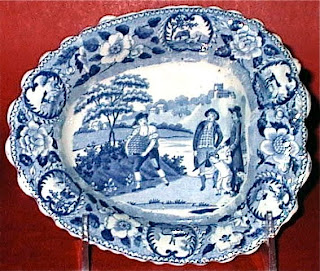 |
| Spode (1770-1833) 7 inch Love Chase pattern plate/printed underglaze in blue and painted over the glaze in iron red, ca. 1810 |
The Love Chase is the story of Atalanta and Hippomenes. It actually starts with Atalanta's father who leaves the infant Atalanta in the forest because she isn't a boy. Atalanta is suckled by a bear and raised by hunters. Suspend disbelief here. A favorite of the goddess Artemis (Diana, virgin goddess of the hunt), Atalanta swears to defend her own virginity. Unfortunately, she reunites with her father who insists that she marry! Atalanta agrees but has conditions. She proposes a foot race. If she wins, her suitor is killed, but if the suitor wins, she will marry him. Surprisingly (at least by 21st century sensibilities), Atalanta has lots of suitors, and not surprisingly there are lots of deaths. I neglected to mention that Atalanta was a superb runner. The best. Our hero Hippomenes (also known as Milanion) knows he cannot win a fair race, so enlists the help of Aphrodite (Venus, the goddess of love). Aphrodite gives Hippomenes three golden apples. At first Atalanta is way ahead of Hippomenes, but he throws one of the golden apples in front of her. She stops to pick it up and Hippomenes passes her. He needs to
use all of the golden apples to win the race. It doesn't seem quite
fair (is love ever fair) that Atalanta is tricked, on the other hand, no
one wants to lose (or be killed). Hippomenes wins the race. Atalanta
and Hippomenes marry, but all is not well. Myths, like life, are never
fairy tales. Aphrodite wasn't satisfied with Hippomenes gratitude, so
she curses him (and Atalanta). Skipping the details, the two are
transformed into lions ( I am not sure this is such a bad thing). Worse
would be the curse of Sisyphus (look it up). I digress.
The whole myth is a preamble to showing you one of my favorite patterns, the "Love Chase." It was made by Spode as early as 1810, and was continued periodically by Copeland and Spode in the 19th and 20th centuries. The pattern strays a bit from the story above. Cupid, Aphrodite's son, is very prominent on the plate. His bow, arrows, and other love accoutrements are in the center. Images of Cupid are located throughout the pattern. There are only two vignettes that actually depict the race. Hippomenes runs behind Atalanta on the right and Atalanta is shown picking up an apple on the left. The bottom photo shows Hippomenes and Atalanta as a loving couple with Cupid trailing behind them. I am not sure what is going on in the last vignette (any help will be appreciated).
 |
| Love Chase detail/Hippomenes and Atalanta during the race (the orange color is from my flash, the color of the plate is as above). |
 |
| Love Chase Detail |
While searching the Internet, I found a lovely painting that could have been the inspiration for Hippomenes throwing the apples.
 |
| Atalanta and Hippomenes by Guido Reno, 1622-1625/The painting is in the Museo Nazionale di Capodimonte in Naples |
When I was a child I loved Greek Mythology. The gods and goddesses were
powerful, but most of the mortals were heroes. I used to
imagine that I would be as clever and strong as a hero. Today, I find
the stories quite dark. No matter what you do, the results of your
choices are not in your control.














































